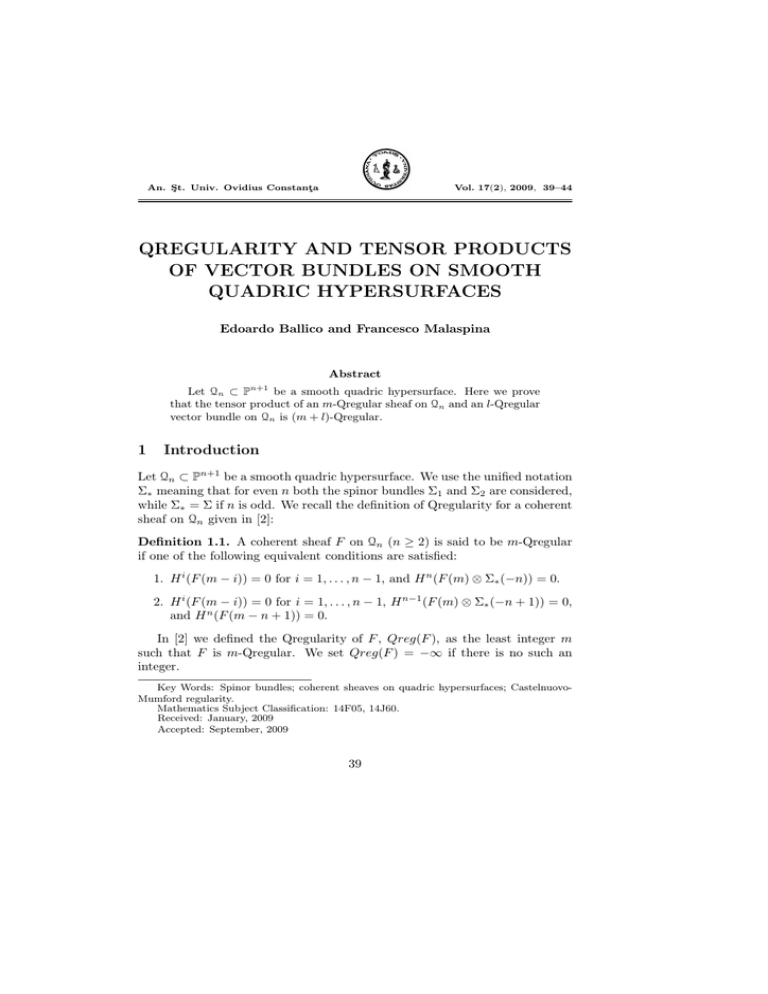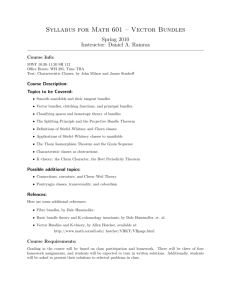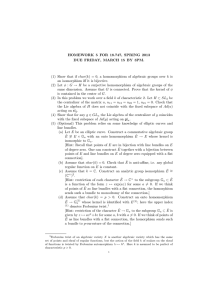QREGULARITY AND TENSOR PRODUCTS OF VECTOR BUNDLES ON SMOOTH QUADRIC HYPERSURFACES
advertisement

An. Şt. Univ. Ovidius Constanţa Vol. 17(2), 2009, 39–44 QREGULARITY AND TENSOR PRODUCTS OF VECTOR BUNDLES ON SMOOTH QUADRIC HYPERSURFACES Edoardo Ballico and Francesco Malaspina Abstract Let Qn ⊂ P be a smooth quadric hypersurface. Here we prove that the tensor product of an m-Qregular sheaf on Qn and an l-Qregular vector bundle on Qn is (m + l)-Qregular. n+1 1 Introduction Let Qn ⊂ Pn+1 be a smooth quadric hypersurface. We use the unified notation Σ∗ meaning that for even n both the spinor bundles Σ1 and Σ2 are considered, while Σ∗ = Σ if n is odd. We recall the definition of Qregularity for a coherent sheaf on Qn given in [2]: Definition 1.1. A coherent sheaf F on Qn (n ≥ 2) is said to be m-Qregular if one of the following equivalent conditions are satisfied: 1. H i (F (m − i)) = 0 for i = 1, . . . , n − 1, and H n (F (m) ⊗ Σ∗ (−n)) = 0. 2. H i (F (m − i)) = 0 for i = 1, . . . , n − 1, H n−1 (F (m) ⊗ Σ∗ (−n + 1)) = 0, and H n (F (m − n + 1)) = 0. In [2] we defined the Qregularity of F , Qreg(F ), as the least integer m such that F is m-Qregular. We set Qreg(F ) = −∞ if there is no such an integer. Key Words: Spinor bundles; coherent sheaves on quadric hypersurfaces; CastelnuovoMumford regularity. Mathematics Subject Classification: 14F05, 14J60. Received: January, 2009 Accepted: September, 2009 39 40 Edoardo Ballico and Francesco Malaspina Here we prove the following property of Qregularity. Theorem 1.2. Let F and G be m-Qregular and l-Qregular coherent sheaves such that T ori (F, G) = 0 for i > 0. Then F ⊗ G is (m + l)-Qregular. In particular this holds if one of them is locally free. The corresponding result is true taking as regularity either the CastelnuovoMumford regularity or (for sheaves on a Grassmannian) the Grassmann regularity defined by J. V. Chipalkatti ([3], Theorem 1.9). The corresponding result is not true (not even if G is a line bundle) on many varieties with respect to geometric collections or n-block collections (very general and very important definitions of regularity discovered by L. Costa and R.-M. Miró-Roig) ([4], [5], [6]). Our definition of Qregularity on smooth quadric hypersurfaces was taylor-made to get splitting theorems and to be well-behaved with respect to smooth hyperplane sections. Theorem 1.2 gives another good property of it. To get Theorem 1.2 we easily adapt Chicalpatti’s proof of [3], Theorem 1.9, except that we found that in our set-up we need one more vanishing. Our proof of this vanishing shows that on smooth quadric hypersurfaces our definition of Qregularity easily gives splitting results (see Lemma 2.2). 2 The proof Set O := OQn . Lemma 2.1. Let F be a 0-Qregular coherent sheaf on Qn . Then F admits a finite locally free resolution of the form: 0 → K n → · · · → K 0 → F → 0, where K j (0 ≤ j < n) is a finite direct sum of line bundles O(−j) and K n is an n-Qregular locally free sheaf. Proof. Since F is globally generated ([2], proposition 2.5), there is a surjective map H 0 (F ) ⊗ O → F. The kernel K is a coherent sheaf and we have the exact sequence 0 → K → H 0 (F ) ⊗ O → F → 0. Since the evaluation map H 0 (F ) ⊗ O → F → 0 induces a bijection of global sections, H 1 (K) = 0 . From the sequences H i−1 (F (−i + 1)) → H i (K(−i + 1)) → H 0 (F ) ⊗ H i (O(−i + 1)) → 0, QREGULARITY AND TENSOR PRODUCTS OF VECTOR BUNDLES ON SMOOTH QUADRIC HYPERSURFACES 41 we see that H i (K(−i + 1)) = 0 for any i (1 < i < n). From the sequences H n−1 (F )⊗Σ∗ (−n+1) → H n (K(1)⊗Σ∗ (−n)) → H 0 (F )⊗H n (Σ∗ (−n+1)) → 0, we see that H n (K(1) ⊗ Σ∗ (−n)) = 0. We conclude that K is 1-Qregular. We apply the same argument to K and we obtain a surjective map H 0 (K(1)) ⊗ O(−1) → K with a 2-Qregular kernel. By the syzygies Theorem we obtain the claimed resolution. Lemma 2.2. Let G an m-Qregular coherent sheaf on Qn such that hn (G(−m− n)) 6= 0. Then G has O(−m) as a direct factor. Proof. Since hn (G(−m − n)) 6= 0, h0 (G∗ (m)) 6= 0 ([1], theorem at page 1). Hence there is a non-zero map τ : G(m) → O. Since G(m) is 0-Qregular, it is spanned ([2], proposition 2.5), i.e. there are an integer N > 0 and a surjection u : ON → G(m). Every non-zero map O → O is an isomorphism. Hence τ ◦ u is surjective and there is v : O → ON such that (τ ◦ u) ◦ v is the identity map of O. Hence the maps τ and v ◦ u : O → G(m) show that G(m) ∼ = O ⊕ G′ with ′ ∼ G = Ker(τ ). Proof of Theorem 1.2. We first reduce to the case in which G is indecomposable. Indeed, if G ∼ = G1 ⊕ G2 where G1 is l-Qregular and G2 is l′ -Qregular (l′ ≤ l), then F ⊗ G1 is (l + m)-Qregular and F ⊗ G2 is (l′ + m)Qregular (l′ + m ≤ l + m) so F ⊗ G ∼ = (F ⊗ G1 ) ⊕ (F ⊗ G2 ) is (l + m)-Qregular. We can assume that G is not O(−l), because the statement is obviously true in this case. Hence by Lemma 2.2 we may assume H n (G(l − n)) = 0. Let us tensorize by G(l) the resolution of F (m). We obtain the following resolution of F ⊗ G: 0 → K n ⊗ G(l) → · · · → K 0 ⊗ G(l) → F ⊗ G(m + l) → 0, where K j (0 ≤ j < n) is a finite direct sum of line bundles O(−j) and K n is a n-Qregular locally free sheaf. Since H n (G(l − n)) = · · · = H 1 (G(l − 1)) = 0, we have H 1 (F ⊗ G(m + l − 1)) = 0. Since H n (G(l − n)) = · · · = H 2 (G(l − 2)) = 0, 42 Edoardo Ballico and Francesco Malaspina we have H 2 (F ⊗ G(m + l − 2)) = 0 and so on. Moreover, H n (G(l) ⊗ Σ∗ (−n)) = 0 implies H n (F ⊗ G(m + l) ⊗ Σ∗ (−n)) = 0. Thus F ⊗ G is (m + l)-Qregular. Proposition 2.3. Let F and G be m-Qregular and l-Qregular vector bundles on Qn . If F is not (m − 1)-Qregular and G is not (l − 1)-Qregular then F ⊗ G is not (m + l − 1)-Qregular. In particular Qreg(F ) = Qreg(G) = 0 implies Qreg(F ⊗ G) = 0. Proof. By the above argument we can prove the result just for F and G indecomposable. Let us assume that G is not (l−1)-Qregular. We can assume that G is not O(−l), because the statement is obviously true in this case. Hence by Lemma 2.2 we may assume H n (G(l − n)) = 0. If H i (G(l − i − 1)) 6= 0 for some i (0 > i > n), and H i+1 (G(l − 1 − i − 1)) = · · · = H n (G(l − n)) = 0, we have an injective map H i (G(l − i − 1)) → H i (F ⊗ G(m + l − i − 1)) and so H i (F ⊗ G(m + l − i − 1)) 6= 0. This means that F ⊗ G is not (m + l − 1)Qregular. If H i (G(l − i − 1)) = 0 for any i (0 > i > n) but H n−1 (G ⊗ Σ∗ (−n)) = 0 by [2] Proof of Theorem 1.2., we have that G ∼ = Σ∗ (−l). By a symmetric argument we may assume that F ∼ = Σ∗ (−m). Now we only need to show that Σ∗ (−m)⊗Σ∗ (−l) is not (m+l−1)-Qregular. Indeed since h0 (Σ∗ ⊗Σ∗ (−1)) = 0, [2] Proposition 2.5 implies that Σ∗ ⊗ Σ∗ is not (−1)-Qregular. Remark 2.4. On Pn if F is a regular coherent sheaf according CastelnuovoMumford, then it admits a finite locally free resolution of the form: 0 → K n → · · · → K 0 → F → 0, where K j (0 ≤ j < n) is a finite direct sum of line bundles O(−j) and K n is an n-regular locally free sheaf. Now arguing as above we can deduce that Theorem 1.2 and Proposition 2.3 hold also on Pn for Castelnuovo-Mumford regularity. References [1] A. Altman and S. Kleiman, Introduction to Grothendieck duality theory, Lect. Notes in Mathematics 146, Springer, Berlin, 1970. QREGULARITY AND TENSOR PRODUCTS OF VECTOR BUNDLES ON SMOOTH QUADRIC HYPERSURFACES 43 [2] E. Ballico and F. Malaspina, Qregularity and an extension of EvansGriffiths Criterion to vector bundles on quadrics, J. Pure Appl Algebra 213 (2009), 194-202. [3] J. V. Chipalkatti, A generalization of Castelnuovo regularity to Grassmann varieties, Manuscripta Math. 102 (2000), no. 4, 447–464. [4] L. Costa and R. M. Miró-Roig, Geometric collections and Castelnuovo-Mumford regularity, Math. Proc. Cambridge Phil. Soc. 143 (2007), no. 3, 557–578. [5] L. Costa and R. M. Miró-Roig, m-blocks collections and CastelnuovoMumford regularity in multiprojective spaces, Nagoya Math. J. 186 (2007), 119–155. [6] L. Costa and R.M. Miró-Roig, Monads and regularity of vector bundles on projective varieties, Michigan Math. J. 55 (2007), no. 2, 417–436. Università di Trento 38123 Povo (TN), Italy Email: ballico@science.unitn.it Politecnico di Torino Corso Duca degli Abruzzi 24, 10129 Torino, Italy Email: francesco.malaspina@polito.it 44 Edoardo Ballico and Francesco Malaspina





